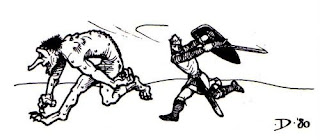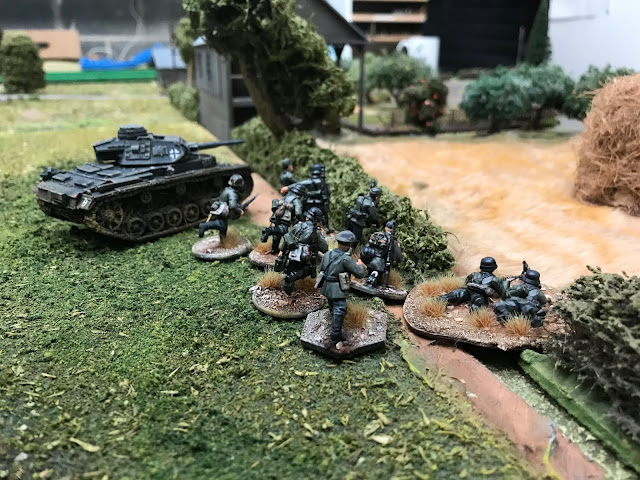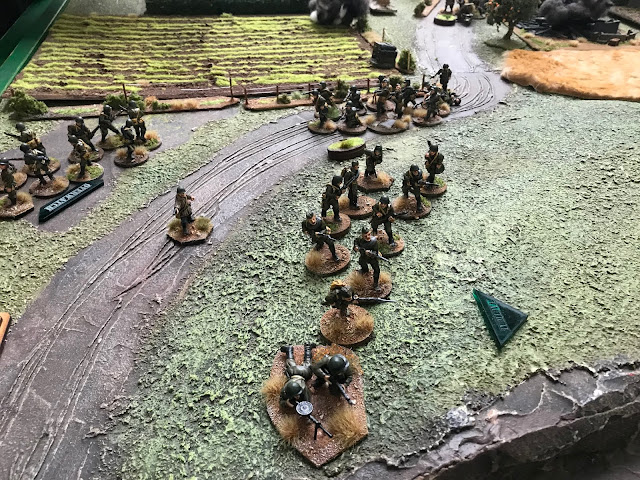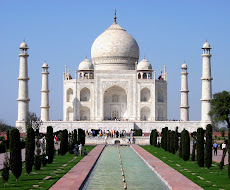Mad Paradox
Japan
Queen Soft (developer and Japanese publisher); Samourai (U.S. publisher)
Released 1992 for PC-98; 1994 for FM Towns and DOS
Date Started: 13 September 2020
Date Ended: 14 September 2020
Total Hours: 8
Difficulty: Easy (2/5)
Final Rating: (to come later)
Ranking at time of posting: (to come later)
Nearly 30 years later, I can't even find any evidence that a company called Samourai existed. The title screen of the game itself is the only evidence. I don't know where they were located or who was on the staff. By all appearances, the company seems to have existed solely to bring Mad Paradox to an American market. I desperately want to find the people involved and ask, why Mad Paradox? Why not any of the host of 1980s and early 1990s Japanese PC RPGs that look so much more interesting? There's Fantasian (1985), which coupled first-person dungeon exploration with top-down grid-based tactical combat before Pool of Radiance did it in the U.S. Was SSI influenced by this Japanese game? I'll never know because I can't play it. Paladin (1985) is a fun-looking RPG-platformer hybrid. There's Riglas (1986), an adventure-RPG hybrid with a "studio" perspective that looks like it could have been influenced by Quest for Glory if Riglas hadn't come out first. There's the delightfully weird-looking Panorama Toh (1983). A bunch of other games I know only from intriguing titles: The Magic of Scheherazade (1987), The Return of Ishtar (1987), Zombie Hunter (1987), Bastard (1988), Druid (1988), Slime Master (1989), Another Genesis (1990). There's a Japanese-only fourth entry in the Phantasie series from 1990. The sin of all of these games, I guess, is that they didn't have breasts.
Mad Paradox has those, but the game is so inept that it forgets it's an eroge at some point and plays the last third entirely straight. Having played Knights of Xentar (1991) and Cobra Mission (1992) before this one, I had certain expectations, and I was shocked--not disappointed, you understand, just surprised--when the game had no final "reward."
That would be fine if there were anything else notable about Mad Paradox, but there isn't. It's a grindy, linear, derivative, ugly game with limited mechanics and a nonsensical story. In basic form and narrative, it's like Knights of Xentar, but with less freedom, more boring combat, and blander characters. It's rare that I say this even about bad games, but there was nothing about the time I spent on it that wasn't a complete waste. I can't tell you much about what's on my "to do" list this week without giving away too much personal information, but suffice to say that there is no stronger justification for my blog's title than the fact that I spent 8 hours of this week of all weeks winning this game.
The opening dialogue is another prime example of the wordiness accompanies a lot of these JRPGs. It's like hearing two children shout, "Am not!" and "Are too!" at each other. One round of it, fine, but after a few repetitions you start wondering if any jury of "your peers" would really convict you. In this case, I had to read through several screens of Mash trying to convince the reluctant Samos to tell him about Gorgus, with the equivalent of "Please tell me!" and "No, it's too dangerous" repeated so often that I began to understand Gorgus's motivations for just killing everyone in this town.
Eventually, Samos relents and sends Mash on a quest that begins with retrieving his father's arms and armor from the old castle. At first, I worried I'd have trouble finding it, but I soon realized that my worries were baseless. The game consists of only about a dozen areas, each taking up only about four screens. Hallways are wide and buildings large, and areas are therefore hard to get lost in. Pathways don't open until you're ready for them and many of them close behind you, so even when it seems like you're stuck, you just have to loop around the NPCs in a small number of screens, and eventually you'll get the next clue.
 |
| The game has furniture, barrels, doors, and chests, but none of them (except about four chests in dungeons) are really interactive. |
Other than combat and NPC "dialogue" (all lines are scripted; there are no choices), there isn't much to do in the game. It lacks any kind of "search" feature. Doors open automatically when you walk into them. NPCs are also activated by walking into them. There are no puzzles, no traps, no out-of-combat spellcasting except for healing. This would describe a lot of games in the 1980s, but it feels like we've come further than this since then.
There is no character creation process. Mash (and, later, his two companions) come to the game with fixed values in strength, stamina, intelligence, attack, defense, maximum health, and maximum magic power, all of which increase upon leveling up. Attack and defense scores increase as you purchase or find better equipment. Enemies have no magic and no special attacks. You never miss them and they almost never miss you, and the damage that you do to each other is fixed by a formula that considers the attacker's attack score and the defender's defense score. Because combat is so predictable, it's also boring. There are no tactics save the spells, but offensive spells aren't that much better than physical attacks. You're almost always better off saving magic ability for healing.
The game is also extremely grindy. There's a maximum of 40 levels, and you have to be close to the top to defeat Gorgus in the end. If you just walked through the areas (and didn't get killed), you'd probably reach the endgame at Level 16. The rest is grinding, which sucks because combat is slow. Every attack, yours or the enemy's, is accompanied by an animation. Thank the gods that someone told me how to use DOSBox's "warp" mode recently or I never would have survived it. Mechanically, combat seems to be derived from Phantasie. Each round, each character attacks, casts a spell, uses an item, or tries to flee, and the action executes immediately with its animation. All characters go before all monsters.
The predictability of combat means that you almost always know when you've entered an area that's out of your pay grade, so that's when it's time to return to an earlier area and camp for a while. Fortunately, I was able to watch educational videos for a class I'm taking during this process. It is not an exaggeration to say that at least 5 of the game's 8 hours were spent grinding.
That leaves the story, which almost doesn't deserve to be related. As Mash leaves Dorah, Samos asks him to keep an eye out for a girl with a fiery brand but otherwise doesn't tell anything about her. Mash first recovers his father's sword (a regular long sword, discarded almost immediately) from the castle, after which Samos opens the way to Death Valley. Before he leaves town, Mash can have his first ribald encounter with a local girl whose name he doesn't even remember.
Each one of Mash's erotic encounters shows three or four pictures of the girl in question, censored in the places that Japanese media typically censors images of girls. None of Mash's encounters are non-consensual, though like Xentar, he is sometimes rewarded with sex (or just images of unclothed girls) in situations where the girls in question have just been through traumatic experiences. As usual, many of the girls look underaged to me, but I'll just accept that's a cultural/artistic thing. The other weird thing is that many of the images . . . I don't know how to say this . . . Many of them suggest that Mash is "participating" in the activities depicted, except that he himself never actually appears. It's as if he's gone invisible. Finally, unlike the heroes of other eroges that we've seen, Mash is not depicted as either particularly suave or particularly inept. He doesn't make jokes or cringy statements about his experiences. They mostly happen without comment, or with bland comment.
Areas of the game are divided into those with wandering creatures and "safe areas" (usually towns) without them. In areas that have creatures, they're always depicted as formless blobs until you run into them and the encounter begins. You can avoid them a lot of the time by walking in the other direction, but the game requires so much grinding that it's best to fight when the blobs are present. They respawn quickly. Each area typically only has two types of creatures. The Valley of Death had ogres and "mantrap plants."
On the other side of the Valley is the city of Garah, which is being menaced by a lieutenant of Gorgus named Gidd. The residents are so terrified that they offer young ladies as sacrifices to Gidd. The latest, chained up and waiting for him to come and get her, is a girl named Lizza. (Lizza disrobes for Mash in exchange for a promise to help her.) Mash also hears about a local young swordswoman named Elle. A third entanglement comes when Mash discovers that the local bartender has imprisoned a girl named Mary in his basement.
Mary supplies the key necessary to unlock Lizza's shackles. Mash creepily has a sexual encounter with Mary before she's even freed from the basement. Lizza returns to her grandmother's cave in a forested area west of town. Lizza's grandmother has some intel on the source of Gorgus's power, which has to do with "plaques" (the way this is used, I can't help think the world is translated badly) that had been created by the gods and covey power over fire, water, and other forces.
At this point, its not clear what Mash has to do to enter Gidd's fortress (the guards repel him if he nears), so it's one of the moments of the game where he has to run back and forth to various NPCs to figure it out. Mary says that to enter the fortress, Mash will need an emblem and suggests he talk again to Lizza. Running back to Lizza's grandmother's cave (fighting zombies along the way), he learns hat Lizza has the emblem tattooed on her thigh (picture follows). Lizza suggests that the blacksmith can make the emblem but he'll need to see it, and Lizza doesn't want to return to town. Mash has to return to town alone and go to a shop where the shopkeeper has an "eternity mirror" that captures an image of whatever it's pointed at, but he won't sell it except for a "goddess statue." This turns out to be in the possession of Lizza's grandmother, necessitating another trip through the woods, then back to the shop, then back to the cave to capture the image, then back to town to deliver the image to the blacksmith. Such is the game padded.
Meanwhile, Mash finally meets Elle, who agrees to help him in his quest, as her father was also killed by Gorgus. After Mash picks up the emblem at the blacksmith's shop, Elle meets him at the gates to Gidd's fortress, which (after grinding a while), they invade, killing guards and dark fairies and ultimately Gidd himself. Gidd leaves behind a crystal ball in which Mash sees an image of a girl with a fire brand on her forehead, the one that Samos told him about.
 |
| Elle is one of the few female characters presented respectfully. |
After defeating Gidd, Elle and Mash move on to the city of Krapp. Krapp has a few exits, one of which goes to the "twin cities" of Aquapolis and Foulwater, the other of which goes to the cities of Blessfire and Foxfire. You understand when I say "cities," I'm talking about a couple of screens with inns, shops, and a few NPCs. Each city has a weapon/armor/shield shop, and I found that the party basically had just enough gold for the latest upgrades at just about the moment they became available.
If you check into the inn with Elle in Krapp, there are some scenes that suggest Mash might have tried to have his way with Elle and was duly reprimanded--this is played for humor, of course. Otherwise, if he checks into the Krapp inn without Elle, he finds that it's a brothel in disguise and has the opportunity to sleep with several prostitutes; there's a sequence exactly like it in Xentar. Great: I've become an expert on tropes in Japanese porn games. Irene will be so pleased.
Elle disappears for a while at one point and is found frolicking with fairies in a waterfall in Aquapolis (with images, of course). In Blessfire, the duo becomes a trio as a warrior named Fugg joins the party to rescue his sister, Lora, who has been taken by Gorgus's next lieutenant, Geir. As before, the party has to get strong enough to raid Geir's fortress, which is populated by giants and necromancers, before taking on the minion himself. Along the way, they free three captive girls (with images, etc.) from Foxfire. Fugg leaves the party after Geir's defeat, which was surprising. I thought the game was going for a permanent hero-girl-male friend composition like Xentar.
 |
| Fugg briefly joins the team. |
I lost track of a lot of the plot at this point, and I can't even reconstruct it with my screen shots. The party found one "plaque" in Krapp, but it didn't seem to do much of anything. Later, there was discussion that they had to find a "crystal" and then "holy water." Moving forward for the rest of the game generally meant circling around between "The Wise One" in Aquapolis, Lizza's grandmother, and an overtly Christian priest in Krapp until one of them had the answer.
Getting the "holy water" meant visiting the city of Heavens, which turned out to be accessible from the waterfall in Aquapolis. The city was under the thumb of Gorgus's final lieutenant, Goses, who as usual had imprisoned a few girls. Freeing them opened the way to his fortress and represented the last eroge content in the game. As Mash freed them, Elle expressed some jealousy, and I set myself up for an ending just like Xentar and Cobra Mission in which the hero swears off his rakish ways and marries his female adventuring companion in a weirdly wholesome epilogue.
Goses's fotress required a lot more grinding. Enemies were dark knights and women that looked like sorceresses but were for some reason called "rusty nails." The combat with Goses himself went like all boss combats in the game. Since no one has any special attacks and all attacks do predictably the same damage, combat was just a matter of figuring out how often I had to cast healing spells in between physical attacks. As long as the enemy doesn't do more damage than you're able to heal, you can eventually whittle him down.
Following Goses's defeat, discussion again turned to things I don't remember discussing previously. Something about having to find a "sanctum" and an "AquaSword." After making the rounds of the usual NPCs, it turned out that the priest knew of a way to open a doorway to some "sanctum" in Aquapolis. We followed his instructions and found ourselves in a long, linear dungeon (a single straight corridor) containing the toughest enemies in the game, lizard warriors called "death tails" and floating balls of light called "ghost balls." They offered so much experience that we finished leveling up just pushing through the corridor.
Gorgus was at the end of it, but he taunted us by saying we could never defeat him without the "AquaSword," which for some reason we didn't have and couldn't find, so we had to back off and return to Krapp. There, the bartender's daughter heard of our plight and stole a "plaque" that the bartender had kept secret. She ran away with it to the forest, where it required her to sacrifice her life to turn into the "Holy Sword," which was apparently capable of defeating Gorgus. This was all told very poorly.
We returned to the Sanctum and engaged Gorgus in combat. It was the same thing as his minions: a couple of attacks followed by a couple of healing spells or potions. It took a long time, but he died.
The denouement was stupid. The girl with the firebrand appeared in the wake of Gorgus's defeat. Gorgus has held her prisoner all her life, telling her she was the daughter of Lord Laggs of Dorah, my father (whose actual name is appearing for the first time), which would seem to make her my sister. Surprisingly, Elle took off at this point, claiming she'd had her revenge. For some reason, Mash expressed an intention to still somehow try to make the "AquaSword," but the nameless girl convinced him it wasn't important and persuaded him to use the holy water to wish their way back to Dorah.
Back in Dorah, Samos filled in the rest of the story, but it still didn't make a lot of sense. It turns out the girl--who is never named--is not the daughter of Lord Laggs but of the ruler of Garah. A soldier carried her out of town when Gorgus destroyed the city; Samos ended up finding her in the woods; and my parents ended up adopting her moments before they themselves were slain by Gorgus. End of story. The girl didn't end up with Mash, either, so I'm not sure why she's even in the game.
The game ends with Samos offering Mash a drink. A black screen says "And . . . time passed by . . . " and then shows an image of someone--Mash, I guess--sitting under a tree at the top of a cliff. And then the credits roll over (non-lewd) images of some of the females in the game. So I have no idea what that end sequence was about, but neither do I really care. The title of the game is never really explained, either, unless that's the paradox.
In a GIMLET, the game earns:
- 2 points for some attempt at a story.
- 2 points for character creation and development. There's no creation, but leveling feels suitably rewarding.
- 3 points for NPCs. They play a big role in the game, but everything is one-way.
- 1 point for encounters. There are no non-combat encounters, and enemies are only differentiated by how hard they hit.
- 2 points for magic and combat. Combat has no real tactics and there's no point to the variety of spells, which is too bad because some of the visual effects for the spells are fun.
- 3 points for the economy. It remains relevant most of the game and is a secondary reason to grind. When you no longer need weapons and armor, you can stock up on healing potions.
- 2 points for equipment. There are upgrades to weapons, armor, and shields, and it feels rewarding to buy them, but there's no complexity to the items. They just adjust attack/defense scores.
- 2 points for a main quest with no options or side quests.
- 3 points for graphics, sound, and interface. I found the graphics grainy (why do they look like they have artificial scan lines?) and the icons hard to make out. Some of the cut scene graphics were well-composed, though. I can't tell you about the sound because the music is so relentless, and can't be turned off separately, that I played with the sound off entirely. The controls work fine.
- 1 point for gameplay. The overall game wasn't too long, but even within the limited time, it wasted a lot of time with grinding and backtracking. The predictability of combat made it too easy; it's very linear; and there's nothing replayable about it.
That give us a final score of 21, which is a pretty low score for the era. I'm glad I investigated what Japanese developers were doing on consoles at the same time because otherwise this would be my impression of JRPGs.
I typically haven't subtracted any points for bad translation, so I won't do that here, but the text of the game is riddled with spelling and syntax errors and poor word choice. Also, it's sometimes hard to tell who's speaking.
Normally, I'd offer reviews from contemporary sources, but I can't find any evidence that anyone noticed this game when it was released in 1992. I can report that and Honest Gamers reviewer named Woodhouse agreed with me in a 2003 review:
To play Mad Paradox is to step into a world of mediocrity. It's an RPG that skimps on all the ingredients that can make an RPG great. The battles are neither unique nor exciting, you're given only an excruciatingly tiny area to explore, and there isn't any engrossing story or character development. The makers of this title decided to forego all those amenities, instead placing an emphasis on pleasing the viewer's visual receptors. To captivate its audience, Mad Paradox relies on its one and only asset, numerous naked women.
I would normally also report on the developers here, but none of them seem to be associated with any other games, including designer and writer Tooru Hamada, senior programmer Kei Ishizuka, senior illustrator Akira Komi, or even music composer Shirahama Nanki. The development company, Queen Soft, did produce at least half a dozen other titles between 1989 and 1996, mostly eroge adventure games and what can only be described as "strip mahjong." Even more of a mystery is the supposed U.S. translator and distributor, Samourai, which is an absolute ghost. I'm not 100% sure that it wasn't just a warez group that created a fan translation. Why any of these obscure individuals thought that this game was worthy of their time will have to remain an enigma. A paradox. A maddening one.




















































